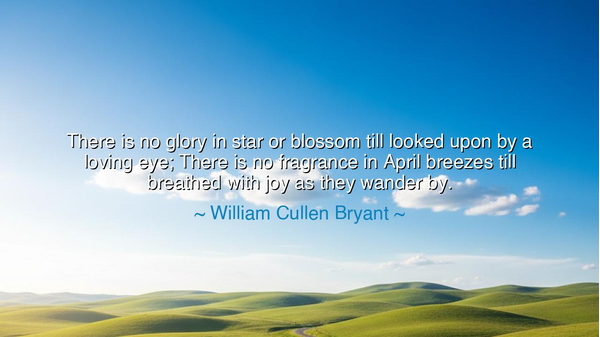
There is no glory in star or blossom till looked upon by a
There is no glory in star or blossom till looked upon by a loving eye; There is no fragrance in April breezes till breathed with joy as they wander by.






Hearken, O children of perception and heart, to the words of William Cullen Bryant, whose verse illuminates the interplay between beauty and human consciousness: “There is no glory in star or blossom till looked upon by a loving eye; There is no fragrance in April breezes till breathed with joy as they wander by.” In these words lies a meditation upon the inseparable bond between the world’s beauty and the soul’s receptivity, a truth as ancient as the stars themselves: the glory of the cosmos and the sweetness of nature are realized only when they are received with awareness and affection.
The essence of this reflection is that beauty exists in communion, not merely in isolation. A star, a blossom, or a wandering breeze holds potential, but it is the human heart that confers recognition, meaning, and joy. Bryant teaches that perception is not passive; it is an active engagement, a co-creation of significance between observer and observed. The world offers wonders endlessly, yet their full power awakens only in those prepared to behold them with reverence and delight.
Consider the life of John Muir, who wandered the wilderness of North America, perceiving mountains, rivers, and forests not simply as scenery, but as embodiments of sublime beauty. In Muir’s eyes, each tree, each flowing river, each gust of wind was charged with meaning, joy, and spirit. His writing and advocacy preserved the natural world for generations, demonstrating that the glory of creation becomes real only when it is recognized and cherished by attentive, loving observers.
Bryant’s words also illuminate the ethical dimension of perception. To see with a loving eye is to cultivate gratitude, mindfulness, and humility. Beauty is not merely ornament; it is an invitation to awareness, reflection, and care. When the human heart engages fully, joy and meaning arise naturally. In this engagement lies the seed of stewardship: we protect and honor what we recognize as precious, aware that its fragrance and glory are inseparable from our conscious appreciation.
Even in modern life, the lesson persists. In the rush of cities, the distractions of labor, and the hum of devices, many fail to notice the small, radiant wonders that surround them. Yet the attentive mind finds awe in a child’s laughter, the color of autumn leaves, the scent of rain, or the evening stars. Bryant reminds us that the glory of life is co-created through perception; without a receptive and loving awareness, the gifts of nature pass unnoticed, their beauty untasted.
This reflection also teaches the importance of joyful engagement. The “April breezes” carry fragrance, yet that fragrance becomes meaningful only when inhaled with delight. Likewise, opportunities, relationships, and experiences in life hold latent power that is realized through active appreciation. To live fully is to cultivate eyes, hearts, and spirits that perceive deeply, breathe joyfully, and honor the presence of wonder in every fleeting moment.
O children of mindfulness, take this teaching to heart: behold the world with love, attention, and joy. Observe the stars, the blossoms, the breezes, and the light of day not as mere objects, but as radiant offerings, enlivened by your awareness. Let your perception awaken gratitude, humility, and delight, and in doing so, allow the beauty of the world to awaken you in return. Through this reciprocal recognition, both observer and observed are enriched.
Thus, let the words of William Cullen Bryant guide your days: glory and fragrance dwell not solely in stars or breezes, but in the attentive and loving consciousness that perceives them. Cultivate joy, presence, and gratitude, and the world’s wonders will be magnified in your life. In this communion between soul and nature, beauty, meaning, and delight become eternal companions, and the ordinary becomes sacred, radiant, and profoundly alive.
If you wish, I can also create a practical guide for cultivating joyful awareness of nature and daily life, inspired by Bryant’s reflection, with exercises for mindfulness, gratitude, and deep perception. Do you want me to do that?






AAdministratorAdministrator
Welcome, honored guests. Please leave a comment, we will respond soon